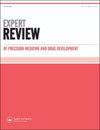MSI-H/dMMR与癌症免疫疗法的现状及未来意义
IF 1.2
Q4 PHARMACOLOGY & PHARMACY
Expert Review of Precision Medicine and Drug Development
Pub Date : 2021-06-30
DOI:10.1080/23808993.2021.1946391
引用次数: 2
摘要
免疫疗法在相对较短的时间内产生了前所未有的算法变化,从而彻底改变了几种血液学和实体瘤的治疗格局[1]。然而,免疫检查点抑制剂(ICIs)被认为对大约三分之一的癌症患者有效,免疫疗法的抗肿瘤活性因不同的恶性肿瘤而异[2]。因此,识别潜在反应者最近已成为医学肿瘤学的关键挑战之一,因为迫切需要开发可靠的生物标志物,指导临床医生选择患者[3,4]。事实上,已经对ICIs反应的几种预测因子进行了测试和评估,其中三种已获得美国食品药品监督管理局(FDA)的批准:程序性死亡配体1(PD-L1)、肿瘤突变负荷(TMB)和微卫星不稳定性/缺陷错配修复(MSI/dMMR)[5]。值得注意的是,所有这些预测因素在方法、特异性以及优势和劣势方面都存在显著差异。作为预测因素和/或预后分层的其他潜在有用因素正在评估中,包括肿瘤过滤淋巴细胞(TIL)[6]。在PD-L1作为非小细胞肺癌癌症预测性生物标志物获得里程碑式批准两年后,2017年,美国食品药品监督管理局批准pembrolizumab用于治疗MSI-high(MSI-H)/dMMR晚期实体瘤患者[7]。特别是,这一批准是基于在五项临床试验中观察到的MSI-H/dMMR恶性肿瘤的结果[7]。事实上,在这些研究中,PD-1抑制剂pembrolizumab在MSI-H/dMMR实体瘤中的总有效率(ORR)和完全有效率(CR)分别为39.6%和7%;此外,78%的应答者的应答持续时间为6个月或更长。值得注意的是,MSI-H的批准具有一定的历史意义,是第一个生物标志物的“孤儿”批准,无论组织学和肿瘤类型如何。从分子角度来看,dMMR恶性肿瘤在整个基因组中积累突变,导致新抗原的形成以及抗肿瘤反应的激活[8]。错配错误在短串联重复中特别常见,因此,突变在微卫星区域更常见,这种情况被称为MSI。有三种不同的检测方法可用于检测MSI-H/dMMR状态:MSI-H的聚合酶链式反应(PCR)和下一代测序(NGS),而dMMR通常通过免疫组织化学(IHC)测定[9]。在临床实践中,两个PCR组更频繁地用于测定MSI-H,其中第一个被称为Bathesda组,包括两个单核苷酸(BAT-25和BAT-26)和三个二核苷酸(D5S346、D2S123和D17S250)重复[10]。值得注意的是,癌症和配对的正常组织对于使用该面板评估MSI-H是必要的。相反,第二组是基于对五个多A单核苷酸重复序列(BAT-25、BAT-26、NR-21、NR-24和NR-27)的评估,与前一组相比显示出更高的特异性和敏感性[11]。此外,该面板不需要正常组织,如果五次重复中至少有两次失去稳定性,则恶性肿瘤被确定为MSI-H。然而,目前通过PCR对MSI-H的评估是基于对选定数量的微卫星的分析,因此,在0.5%至10%的病例中观察到假阴性结果[12]。此外,MSI-H的患病率因肿瘤类型而异,在几种恶性肿瘤中没有可用的数据,包括肾细胞癌和黑色素瘤;相反,其他恶性肿瘤的患病率约为1-2%[13]。NGS方法已被评估,以克服与通过PCR评估MSI-H/dMMR相关的限制[14]。事实上,这种基于肿瘤基因组或全外显子组测序的新检测方法有可能评估几种不同类型的微卫星;此外,NGS可用于所有恶性肿瘤,并能够评估TMB。因此,NGS对MSI-H/dMMR的评估也可以整合TMB[15];然而,NGS存在一些缺点,包括成本高和缺乏广泛的可用性。IHC是另一种常用于通过评估MLH1、MSH2、MSH6和PMS2来确定dMMR的方法,其中至少一种MMR蛋白的表达损失被定义为dMMR[16]。IHC的优势包括其简单性和成本;此外,IHC非常可用,并且可以在所有中心轻松完成。然而,IHC有一些重要的弱点,包括本文章由计算机程序翻译,如有差异,请以英文原文为准。
MSI-H/dMMR and cancer immunotherapy: current state and future implications
Immunotherapy has revolutionized the treatment landscape of several hematological and solid tumors by producing unprecedented algorithm shifts in a relatively short period of time [1]. However, immune checkpoint inhibitors (ICIs) have been suggested to be effective in approximately onethird of all cancer patients, with the antitumor activity of immunotherapy varying among different malignancies [2]. Thus, the identification of potential responders has recently become one of the key challenges in medical oncology, since there is an urgent need to develop reliable biomarkers that could guide clinicians in patient selection [3,4]. In fact, several predictors of response to ICIs have been tested and evaluated, three of whom have been approved by the United States Food and Drug Administration (FDA): programmed death ligand 1 (PD-L1), tumor mutational burden (TMB), and microsatellite instability/defective mismatch repair (MSI/dMMR) [5]. Notably enough, all these predictors present notable differences in terms of methodology and specificity as well as strengths and weaknesses. Other potentially useful elements as predictors and/or for prognostic stratification are under evaluation, including tumorinfiltrating lymphocytes (TILs) [6]. Two years after the landmark approval of PD-L1 as predictive biomarker in non-small cell lung cancer (NSCLC), pembrolizumab was approved by the FDA for the treatment of patients with MSI-high (MSI-H)/dMMR advanced solid tumors in 2017 [7]. In particular, this approval was based on the results observed in MSI-H/dMMR malignancies across five clinical trials [7]. In fact, in these studies, the PD-1 inhibitor pembrolizumab reported an overall response rate (ORR) and a complete response (CR) rate of 39.6% and 7%, respectively, in MSI-H/dMMR solid tumors; in addition, the 78% of responders presented duration of response of 6 months or longer. Notably enough, the approval of MSI-H had some historical significance, being the first ‘orphan’ approval of a biomarker, regardless of histology and tumor type. From a molecular point of view, dMMR malignancies accumulate mutations across the genome, leading to the formation of neoantigens as well as the activation of antitumor responses [8]. Mismatch errors are particularly frequent in short tandem repeats, and thus, mutations are more commonly observed in microsatellite regions, a condition termed as MSI. Three different testing methods are available for detecting MSI-H/dMMR status: polymerase chain reaction (PCR) and next-generation sequencing (NGS) for MSI-H while dMMR is commonly determined through immunohistochemistry (IHC) [9]. Two PCR panels are more frequently used in clinical practice to determine MSI-H, the first of which is known as the Bathesda panel, including two mononucleotide (BAT-25 and BAT-26) and three dinucleotide (D5S346, D2S123, and D17S250) repeats [10]. Of note, both cancer and paired normal tissue are necessary for the evaluation of MSI-H using this panel. Conversely, the second panel is based on the assessment of five poly-A mononucleotide repeats (BAT-25, BAT-26, NR-21, NR-24, and NR-27), and has shown higher specificity and sensitivity compared with the previous one [11]. In addition, this panel does not require normal tissue, and if at least two out of five repeats lose stability, the malignancy is determined as MSI-H. However, the assessment of MSI-H by PCR is currently based on the analysis of a selected number of microsatellites, and thus, false negative results are observed in a proportion ranging from 0.5% to 10% of cases [12]. In addition, the prevalence of MSI-H varies greatly according to the tumor type, with no data available in several malignancies, including renal cell carcinoma and melanoma; conversely, other malignancies present a prevalence of approximately 1– 2% [13]. NGS approaches have been evaluated to overcome the limitations associated to the assessment of MSI-H/dMMR through PCR [14]. In fact, this novel assay based on tumor gene panels or whole exome sequencing has the potential to evaluate several different types of microsatellites; in addition, NGS may be used for all malignancies and is able to evaluate TMB. Thus, the evaluation of MSI-H/dMMR by NGS could also integrate TMB [15]; however, NGS presents some disadvantages, including its high cost and the lack of wide availability. IHC is another method commonly used to determine dMMR through the evaluation of MLH1, MSH2, MSH6, and PMS2, where the loss of expression of at least one MMR protein is defined as dMMR [16]. The strengths of IHC include its simplicity and cost; in addition, IHC is greatly available and may be easily done in all centers. However, IHC has some important weaknesses, including the low
求助全文
通过发布文献求助,成功后即可免费获取论文全文。
去求助
来源期刊

Expert Review of Precision Medicine and Drug Development
PHARMACOLOGY & PHARMACY-
CiteScore
2.30
自引率
0.00%
发文量
9
期刊介绍:
Expert Review of Precision Medicine and Drug Development publishes primarily review articles covering the development and clinical application of medicine to be used in a personalized therapy setting; in addition, the journal also publishes original research and commentary-style articles. In an era where medicine is recognizing that a one-size-fits-all approach is not always appropriate, it has become necessary to identify patients responsive to treatments and treat patient populations using a tailored approach. Areas covered include: Development and application of drugs targeted to specific genotypes and populations, as well as advanced diagnostic technologies and significant biomarkers that aid in this. Clinical trials and case studies within personalized therapy and drug development. Screening, prediction and prevention of disease, prediction of adverse events, treatment monitoring, effects of metabolomics and microbiomics on treatment. Secondary population research, genome-wide association studies, disease–gene association studies, personal genome technologies. Ethical and cost–benefit issues, the impact to healthcare and business infrastructure, and regulatory issues.
 求助内容:
求助内容: 应助结果提醒方式:
应助结果提醒方式:


